免疫球蛋白的结构与功能的关系
igm的结构域

igm的结构域摘要:1.IGM的结构域概述2.IGM的结构域类型及其功能3.IGM结构域在生物学中的应用4.结构域互作与蛋白质功能调控5.研究IGM结构域的方法与技术6.未来发展趋势与展望正文:免疫球蛋白M(IGM)是一类具有五个结构域的抗体,分布于哺乳动物的血清、组织液和外分泌液中。
IGM的结构域主要包括:弗林(Fc)、球状头部(CH1-CH2-CH3)和受体结合结构域(Fab)。
这些结构域在免疫应答、病原体清除和免疫调控等生物过程中发挥着重要作用。
1.IGM的结构域概述IGM的结构域可大致分为两类:恒定结构域和可变结构域。
恒定结构域主要包括Fc和CH2,它们在不同免疫球蛋白(Ig)类别中具有高度保守性。
可变结构域主要包括CH1、CH3和CH4,它们在不同IgM亚类中具有显著差异。
2.IGM的结构域类型及其功能(1)Fc结构域:Fc结构域是IgG、IgA、IgM等抗体分子的共同组成部分。
它可与多种效应分子结合,如吞噬细胞、补体系统和细胞毒性T细胞等,发挥抗体依赖性细胞毒作用(ADCC)和免疫调理作用。
(2)CH1结构域:CH1结构域位于IgM的N端,与抗原结合有关。
它具有抗原结合位点,能与病原体和其他抗原分子发生特异性结合。
(3)CH2结构域:CH2结构域主要负责与免疫细胞表面的Fc受体结合,介导抗体依赖性细胞免疫应答。
(4)CH3和CH4结构域:CH3和CH4结构域位于IgM的C端,参与抗体分子的稳定性和亲和力调控。
3.IGM结构域在生物学中的应用IGM结构域在生物学中具有广泛应用,如免疫诊断、治疗和疫苗研究等。
抗体的结构域可用于开发针对特定病原体的诊断试剂,也可用于设计和优化针对肿瘤、自身免疫病等疾病的治疗性抗体。
4.结构域互作与蛋白质功能调控IGM结构域间的互作以及与其他蛋白质结构的相互作用,对调控抗体功能具有重要意义。
例如,Fc与Fc受体结合可激活免疫细胞,促进免疫应答;CH2与吞噬细胞上的免疫球蛋白受体结合,有助于抗体依赖性吞噬作用(ADCP)的实现。
蛋白质的结构与功能
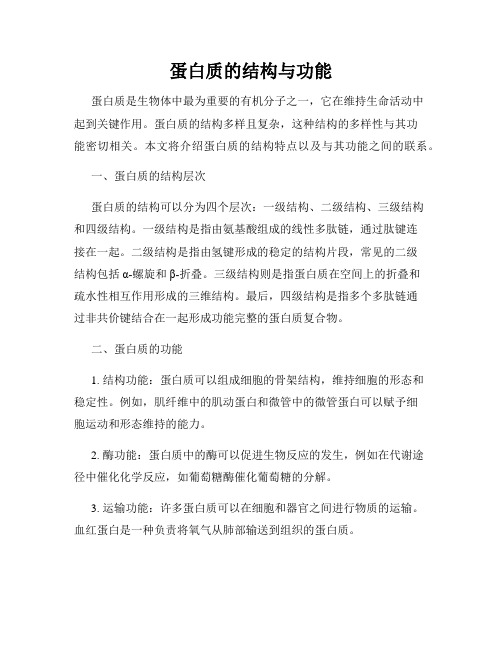
蛋白质的结构与功能蛋白质是生物体中最为重要的有机分子之一,它在维持生命活动中起到关键作用。
蛋白质的结构多样且复杂,这种结构的多样性与其功能密切相关。
本文将介绍蛋白质的结构特点以及与其功能之间的联系。
一、蛋白质的结构层次蛋白质的结构可以分为四个层次:一级结构、二级结构、三级结构和四级结构。
一级结构是指由氨基酸组成的线性多肽链,通过肽键连接在一起。
二级结构是指由氢键形成的稳定的结构片段,常见的二级结构包括α-螺旋和β-折叠。
三级结构则是指蛋白质在空间上的折叠和疏水性相互作用形成的三维结构。
最后,四级结构是指多个多肽链通过非共价键结合在一起形成功能完整的蛋白质复合物。
二、蛋白质的功能1. 结构功能:蛋白质可以组成细胞的骨架结构,维持细胞的形态和稳定性。
例如,肌纤维中的肌动蛋白和微管中的微管蛋白可以赋予细胞运动和形态维持的能力。
2. 酶功能:蛋白质中的酶可以促进生物反应的发生,例如在代谢途径中催化化学反应,如葡萄糖酶催化葡萄糖的分解。
3. 运输功能:许多蛋白质可以在细胞和器官之间进行物质的运输。
血红蛋白是一种负责将氧气从肺部输送到组织的蛋白质。
4. 免疫功能:免疫球蛋白可以识别和结合病原体,从而触发免疫反应,并协助淋巴细胞杀伤病原体。
5. 调节功能:一些蛋白质可以调节细胞内物质的合成和代谢,包括细胞凋亡、基因表达和信号转导等过程。
6. 结合功能:许多蛋白质具有结合小分子的能力,如激素与其相应的受体的结合。
三、蛋白质结构与功能的关系蛋白质的结构决定其功能,不同的结构使得蛋白质能够在特定的环境中担任特定的功能。
例如,蛋白质的二级结构决定了其折叠形态和稳定性,从而影响其功能的发挥。
另外,蛋白质的胺基酸序列决定了其结构的折叠方式和功能区域的位置。
蛋白质的功能也会受到环境因素的影响。
例如,温度、PH值和离子浓度等环境因素都可以改变蛋白质的结构和功能。
当蛋白质受到变性剂的作用时,其结构会发生破坏,功能也会丧失。
总结起来,蛋白质的结构与功能之间存在密切的关系。
免疫球蛋白的结构与功能的关系
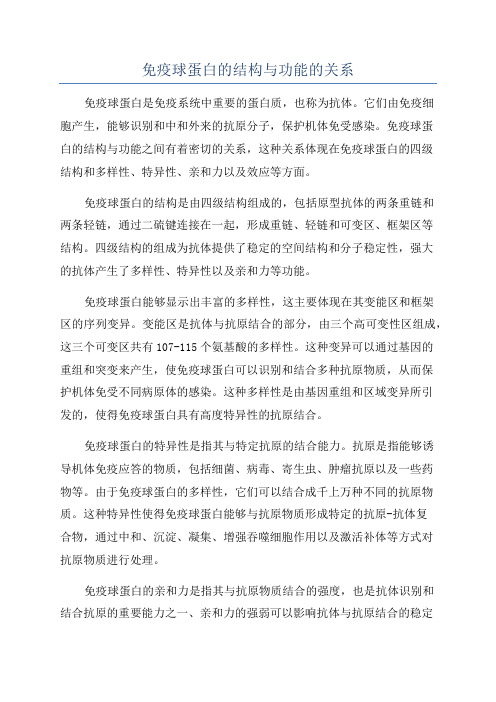
免疫球蛋白的结构与功能的关系免疫球蛋白是免疫系统中重要的蛋白质,也称为抗体。
它们由免疫细胞产生,能够识别和中和外来的抗原分子,保护机体免受感染。
免疫球蛋白的结构与功能之间有着密切的关系,这种关系体现在免疫球蛋白的四级结构和多样性、特异性、亲和力以及效应等方面。
免疫球蛋白的结构是由四级结构组成的,包括原型抗体的两条重链和两条轻链,通过二硫键连接在一起,形成重链、轻链和可变区、框架区等结构。
四级结构的组成为抗体提供了稳定的空间结构和分子稳定性,强大的抗体产生了多样性、特异性以及亲和力等功能。
免疫球蛋白能够显示出丰富的多样性,这主要体现在其变能区和框架区的序列变异。
变能区是抗体与抗原结合的部分,由三个高可变性区组成,这三个可变区共有107-115个氨基酸的多样性。
这种变异可以通过基因的重组和突变来产生,使免疫球蛋白可以识别和结合多种抗原物质,从而保护机体免受不同病原体的感染。
这种多样性是由基因重组和区域变异所引发的,使得免疫球蛋白具有高度特异性的抗原结合。
免疫球蛋白的特异性是指其与特定抗原的结合能力。
抗原是指能够诱导机体免疫应答的物质,包括细菌、病毒、寄生虫、肿瘤抗原以及一些药物等。
由于免疫球蛋白的多样性,它们可以结合成千上万种不同的抗原物质。
这种特异性使得免疫球蛋白能够与抗原物质形成特定的抗原-抗体复合物,通过中和、沉淀、凝集、增强吞噬细胞作用以及激活补体等方式对抗原物质进行处理。
免疫球蛋白的亲和力是指其与抗原物质结合的强度,也是抗体识别和结合抗原的重要能力之一、亲和力的强弱可以影响抗体与抗原结合的稳定性和强度,在一定程度上影响着免疫球蛋白的效能。
亲和力的大小与抗体的各种因素有关,包括可变区的氨基酸序列、特定的序列间作用、抗体构象以及各种结合位点的相互作用等。
通过不断的突变和筛选,免疫系统可以产生亲和力更高的抗体来提高免疫应答的效果。
免疫球蛋白的效应是指其通过与抗原结合而诱导的一系列生理和免疫反应。
举例说明蛋白质结构与功能的关系

举例说明蛋白质结构与功能的关系蛋白质是生物体内广泛存在的一类生物大分子,具有多种生物学功能,如酶的催化作用、结构的支撑作用和信号传导等。
蛋白质的功能与其结构密切相关,不同的蛋白质结构决定其特定的功能。
以下是举例说明蛋白质结构与功能的关系:1.酶的催化作用:酶是一类特殊的蛋白质,能够加速化学反应的进行。
酶的催化作用与其结构中的活性部位密切相关。
酶的活性部位通常由特定的氨基酸残基组成,形成酶与底物之间的亲合力,使得化学反应发生。
例如,酶类蛋白质淀粉酶可以加速淀粉分解为葡萄糖分子,从而提供能量。
2. 信号传导:蛋白质在细胞内参与细胞信号传导过程。
蛋白质的结构决定其与其他分子的结合情况,从而调控细胞内的信号转导通路。
例如,受体蛋白质是细胞膜上的蛋白质,能够与特定的信号分子结合并传导信号到细胞内部。
另外,信号分子可以改变蛋白质的构象,进而调节蛋白质的功能。
例如,Ras蛋白质的构象变化与其信号传导通路的激活密切相关。
3.结构的支撑和稳定:蛋白质可以作为细胞内外的结构支撑和稳定剂。
纤维蛋白质是一类线性排列的蛋白质,具有高度的机械强度,可以形成动物体内的组织结构,如肌肉和骨骼。
胶原蛋白是一种在真皮组织中广泛存在的蛋白质,具有支撑和保护结构的功能,维持皮肤的弹性和韧性。
4.运输和传递:一些蛋白质可以在生物体内运输和传递物质。
血红蛋白是一种在红细胞中丰富的蛋白质,能够与氧气结合并在体内输送氧气。
血红蛋白中的铁原子与氧气发生配位作用,形成氧合血红蛋白,从肺部运输氧气到组织器官,释放氧气供细胞使用。
5.免疫功能:免疫球蛋白是一类免疫系统中重要的蛋白质,具有识别和清除外来抗原的功能。
免疫球蛋白的结构决定了其与抗原结合并触发免疫应答的能力。
当免疫球蛋白与外来抗原结合后,会激活免疫系统的其他成分,如补体系统和巨噬细胞,发起身体对抗原的免疫反应。
总之,蛋白质的结构与功能密切相关,不同的结构决定了蛋白质的特定功能。
蛋白质的结构可以通过物理、化学条件的改变发生变化,进而影响其功能。
第四章 免疫球蛋白

Ab=Ig,Ig≠Ab;Ab是功能描述,Ig是化学结构描述;
第二节 免疫球蛋白的结构
一 、Ig的基本结构
(一)、重链和轻链 Ig的两条长链称为重链(Heavy chain, H链),
含 450-550aa,分子量为50-75kD。
重链可分为μ、γ、α、δ、ε链
IgM IgG IgA IgD IgE
2.功能区的作用
VL+VH区: 抗原结合部位(2个)
V区
CL和CH 区:具有同种 异型抗体的遗传标记。 (2个)
铰链区:赋予弹性 和伸展性. CH2区:IgG的补体结 合点和通过胎盘的部位
C区
CH3区:是Ig与多种
细胞Fc受体结合的部 位.
二、Ig的其他结构
(一)连接链(J链):富含半胱氨酸得多肽链
由浆细胞合成的一种糖蛋白。
IgA和IgM含有J链
可稳定Ig多聚体的成份
(二)分泌片 是分泌型IgA(sIgA)的一个辅助成分,
为一种糖肽,由粘膜上皮细胞合成和分泌。
介导IgA二聚体的转运
保护sIgA的铰链区免受蛋白酶的水解破坏
sIgA
分泌片
J链
三 Ig的酶解片断
1.木瓜蛋白酶
2个Fab 段:结合抗原 1个Fc段:结合细胞 2.胃蛋白酶 F(ab’)段:双价抗体活性 pFc’段:无生物学活性
第四节Ig的基因及抗体的多样性
一、Ig的基因结构 1.Ig轻链基因结构 (1)Ig κ 型轻链基因:Vκ
小鼠:350
、Jκ 、Cκ
5 1
人:100
5
1
(2)Igλ 型轻链基因:Vλ
小鼠:2
、Jλ
4
、Cλ
4
人:2
简述抗体的基本结构和生物学功能

简述抗体的基本结构和生物学功能抗体,也称为免疫球蛋白,是一种由哺乳动物免疫系统产生的蛋白质分子,具有多种结构和功能。
抗体具有重链和轻链组成,每个抗体分子由两个重链和两个轻链组成,形成Y形状。
抗体的基本结构包括可变区和恒定区,可变区决定了抗体的特异性,恒定区则决定了抗体的生物学功能。
抗体的结构可以分为四个区域:两个抗原结合部位,一个球部和一个棒部。
抗原结合部位位于抗体的顶端,并与抗原结合形成特异性复合物。
抗原结合部位的可变区域由重链和轻链的V区域共同决定,具有高度多样性,可以识别并结合多种抗原。
抗体的球部由重链和轻链的C区域组成,决定了抗体的种类和亚类。
棒部由抗体的重链的C区域组成,可与机体免疫细胞相互作用。
抗体的生物学功能包括中和病原微生物、沉淀抗原、激活补体系统、识别和标记异物、调节免疫应答等。
抗体可以通过与病原微生物的抗原结合来中和病原微生物,阻止其侵入机体细胞。
抗体还可以与抗原结合形成沉淀复合物,促使病原微生物和抗原沉淀而不再对机体产生损害。
抗体还可以与补体系统相互作用,激活补体系统来清除病原微生物。
此外,抗体还可以识别和标记异物,使其易于被机体免疫细胞识别和清除。
此外,抗体还可以调节免疫应答,通过与抗原结合来激活或抑制其他免疫细胞的功能,调节免疫应答的强度和方向。
抗体的生物学功能还可以通过其结构的多样性和可选择性来实现。
抗体的可变区域具有高度多样性,可以识别和结合多种抗原,因此可以用于特异性识别和治疗多种疾病。
抗体还可以通过亲和力成对的方式结合抗原,形成二聚体或多聚体,增强抗体的结合力和生物学功能。
总之,抗体具有重链和轻链组成的Y形结构,包括可变区和恒定区。
抗体的主要生物学功能包括中和病原微生物、沉淀抗原、激活补体系统、识别和标记异物、调节免疫应答等。
抗体的多样性和可选择性使其成为免疫系统中重要的分子,具有广泛的应用前景。
蛋白质结构与功能关系

蛋白质结构与功能关系蛋白质是生命活动的主要承担者,它们在细胞内执行着各种各样的功能,从催化化学反应到运输物质、调节生理过程以及提供结构支持等。
而蛋白质的功能与其结构密切相关,结构决定功能是蛋白质研究中的一个核心原则。
蛋白质的结构具有多个层次。
最基本的层次是氨基酸的线性序列,也称为一级结构。
氨基酸通过肽键连接形成多肽链,多肽链中的氨基酸种类、数量和排列顺序决定了蛋白质的特性。
例如,不同的氨基酸具有不同的化学性质,亲水性或疏水性、带正电或负电等。
二级结构是指多肽链在局部区域形成的有规律的重复构象,主要包括α螺旋和β折叠。
α螺旋就像一个弹簧,通过氢键维持稳定;β折叠则像是折叠起来的纸张,相邻的肽链段之间形成氢键。
三级结构是整条多肽链的三维空间构象,包括侧链的空间排布。
它是由二级结构进一步折叠、盘绕形成的,通过疏水相互作用、氢键、离子键和范德华力等多种作用力来维持稳定。
比如,血红蛋白由四个亚基组成,每个亚基都有特定的三级结构,共同协作实现氧气的运输功能。
四级结构则是指由两条或两条以上具有独立三级结构的多肽链通过非共价键相互结合形成的更复杂的结构。
例如,免疫球蛋白由两条重链和两条轻链组成,这种四级结构使得它能够识别和结合特定的抗原。
蛋白质的结构决定了其功能。
以酶为例,酶具有催化化学反应的能力,这是因为其活性部位的结构能够与底物特异性结合,并通过一系列的化学作用促进反应的进行。
酶的活性部位通常具有特定的氨基酸残基,它们的空间位置和化学性质使得底物能够在正确的位置和方向上发生反应。
又如,抗体能够识别和结合外来的抗原物质,这是因为抗体的结构具有能够与抗原互补的结合位点。
这种特异性的结合使得免疫系统能够准确地识别和清除病原体。
蛋白质结构的微小变化可能会导致功能的显著改变。
例如,镰状细胞贫血是由于血红蛋白分子中一个氨基酸的突变,导致血红蛋白的结构发生变化,从而影响了其运输氧气的功能,使得患者的红细胞变成镰刀状,引发一系列的健康问题。
免疫球蛋白igg检测原理_概述及解释说明
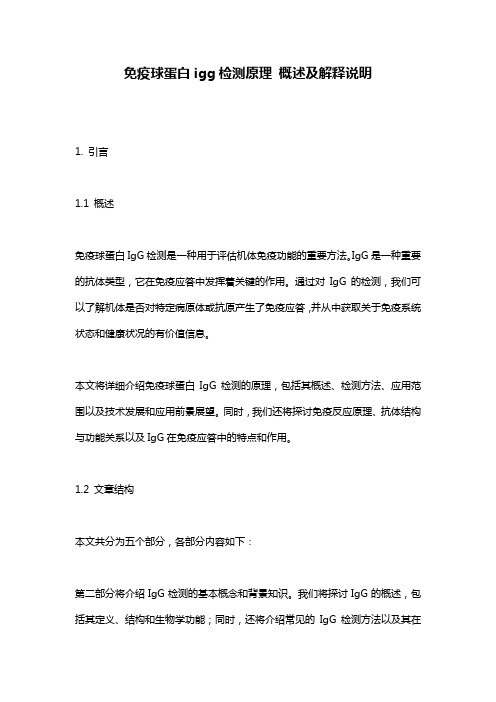
免疫球蛋白igg检测原理概述及解释说明1. 引言1.1 概述免疫球蛋白IgG检测是一种用于评估机体免疫功能的重要方法。
IgG是一种重要的抗体类型,它在免疫应答中发挥着关键的作用。
通过对IgG的检测,我们可以了解机体是否对特定病原体或抗原产生了免疫应答,并从中获取关于免疫系统状态和健康状况的有价值信息。
本文将详细介绍免疫球蛋白IgG检测的原理,包括其概述、检测方法、应用范围以及技术发展和应用前景展望。
同时,我们还将探讨免疫反应原理、抗体结构与功能关系以及IgG在免疫应答中的特点和作用。
1.2 文章结构本文共分为五个部分,各部分内容如下:第二部分将介绍IgG检测的基本概念和背景知识。
我们将探讨IgG的概述,包括其定义、结构和生物学功能;同时,还将介绍常见的IgG检测方法以及其在临床诊断、药物治疗监测和疫苗评估中的应用范围。
第三部分将深入解释IgG检测的原理。
我们将探讨免疫反应的基本原理,包括抗原与抗体之间的特异性识别和结合作用;同时,还将详细介绍抗体结构与功能关系,以及IgG在免疫应答中的特点和作用机制。
第四部分将重点关注IgG检测技术的发展和应用前景。
我们将回顾已有的技术进展和创新,包括高通量检测平台、自动化处理系统等;同时,还将对未来的应用前景进行展望,并讨论相关挑战以及对社会和医学领域所带来的影响和意义。
最后,在第五部分中,我们将对全文内容进行简要总结,并对免疫球蛋白IgG 检测原理进行评价和展望。
通过本文的阐述,我们希望读者能够更加全面地了解免疫球蛋白IgG检测原理及其在临床实践中的重要意义。
1.3 目的本文旨在提供关于免疫球蛋白IgG检测原理的详细解说和解释,以增进读者对该检测方法的认识和理解。
通过对IgG检测的原理和应用进行全面阐述,我们希望能够引起人们对免疫系统功能评估的关注,并为相关领域的科学研究、医学诊断及药物开发提供参考和启示。
通过深入了解IgG检测技术的发展趋势和前景,我们也可以看到未来在这一领域中可能出现的新机遇和挑战。
名词解释免疫球蛋白
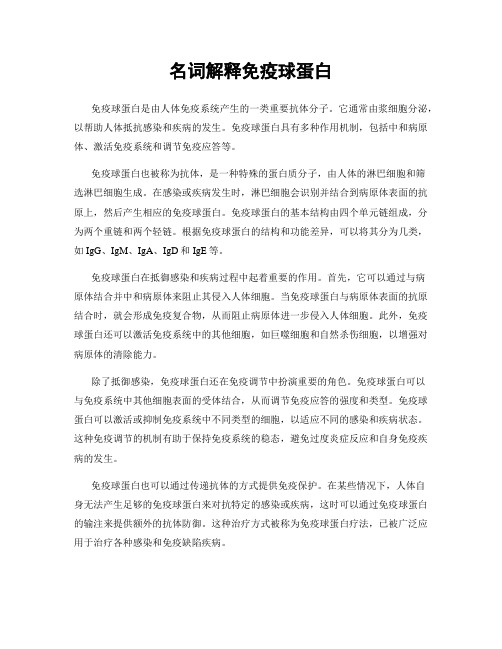
名词解释免疫球蛋白免疫球蛋白是由人体免疫系统产生的一类重要抗体分子。
它通常由浆细胞分泌,以帮助人体抵抗感染和疾病的发生。
免疫球蛋白具有多种作用机制,包括中和病原体、激活免疫系统和调节免疫应答等。
免疫球蛋白也被称为抗体,是一种特殊的蛋白质分子,由人体的淋巴细胞和筛选淋巴细胞生成。
在感染或疾病发生时,淋巴细胞会识别并结合到病原体表面的抗原上,然后产生相应的免疫球蛋白。
免疫球蛋白的基本结构由四个单元链组成,分为两个重链和两个轻链。
根据免疫球蛋白的结构和功能差异,可以将其分为几类,如IgG、IgM、IgA、IgD和IgE等。
免疫球蛋白在抵御感染和疾病过程中起着重要的作用。
首先,它可以通过与病原体结合并中和病原体来阻止其侵入人体细胞。
当免疫球蛋白与病原体表面的抗原结合时,就会形成免疫复合物,从而阻止病原体进一步侵入人体细胞。
此外,免疫球蛋白还可以激活免疫系统中的其他细胞,如巨噬细胞和自然杀伤细胞,以增强对病原体的清除能力。
除了抵御感染,免疫球蛋白还在免疫调节中扮演重要的角色。
免疫球蛋白可以与免疫系统中其他细胞表面的受体结合,从而调节免疫应答的强度和类型。
免疫球蛋白可以激活或抑制免疫系统中不同类型的细胞,以适应不同的感染和疾病状态。
这种免疫调节的机制有助于保持免疫系统的稳态,避免过度炎症反应和自身免疫疾病的发生。
免疫球蛋白也可以通过传递抗体的方式提供免疫保护。
在某些情况下,人体自身无法产生足够的免疫球蛋白来对抗特定的感染或疾病,这时可以通过免疫球蛋白的输注来提供额外的抗体防御。
这种治疗方式被称为免疫球蛋白疗法,已被广泛应用于治疗各种感染和免疫缺陷疾病。
在免疫球蛋白疗法中,免疫球蛋白通常通过血浆捐赠者获得。
这些捐赠者的血浆中含有充足的免疫球蛋白,经过精细的加工和纯化后,可以制备成纯净的免疫球蛋白制剂。
由于免疫球蛋白制剂的制备过程较为复杂,以及免疫球蛋白的种类和含量不同,使得不同类型的免疫球蛋白制剂在临床应用中具有各自的适应症和用法。
第四章免疫球蛋白

(Immunoglobulin,Ig)
内
容
一、抗体与免疫球蛋白 二、免疫球蛋白的分子结构 三、各类免疫球蛋白的特点与功能 四、抗体的生物学活性 五、免疫球蛋白的血清型
抗体——生物体最奇妙的分子
●无限的多样性(diversity)
●功能与结构的双重性
可变区——抗原特异性结合
(三)IgA
分为血清型和分泌型两种。 血清型IgA主要由肠系膜淋巴组织中的浆细胞产生,为 单体。有抗菌、抗病毒、抗毒素的作用。 分泌型IgA(sIgA)是由呼吸道、消化道、泌尿生殖道 等处的固有层中浆细胞产生,为双体、三体或多体。
四肽链对称结构 ,链间二硫键连接 两条相同的重链(heavy chain,H)和两条相同的轻 链(light chain,L) 氨基端和羧基端。
1.重链与轻链
1.重链(heavy chain,H链)
400~500个氨基酸残基,分子量约50~70kD。 根据Ig重链抗原性的差异,Ig可分为五类 即 IgG、IgM、IgA、IgD、IgE, 相应H链为γ、 μ、 α、 δ及 ε链。
Arne Wilhelm Kaurin Tiselius 1948 The Nobel Prize in Chemistry
Elvin A. Kabat 1914–2000
与抗体有关的诺贝尔奖获得者
1901 1908 von Bering Ehrlich & Metchnikoff 血清治疗 抗体生成、吞噬
2、结合Fc受体
Ig的Fc段经与不同细胞表面的Fc受体(FcR)结合,可 表现出不同功能 (1) 调理作用(opsonization) 是指抗体、补体等调 理素(opsonin)促进吞噬细胞吞噬细菌等颗粒性抗原的作用。 抗体的调理作用是指IgG或IgA抗体的Fc段与中性粒细胞、 巨噬细胞、嗜酸性粒细胞等的相应 Fc受体结合,从而增 强吞噬细胞的吞噬作用
蛋白质结构与功能阐述蛋白质结构如何决定其功能以及不同蛋白质在细胞中的作用
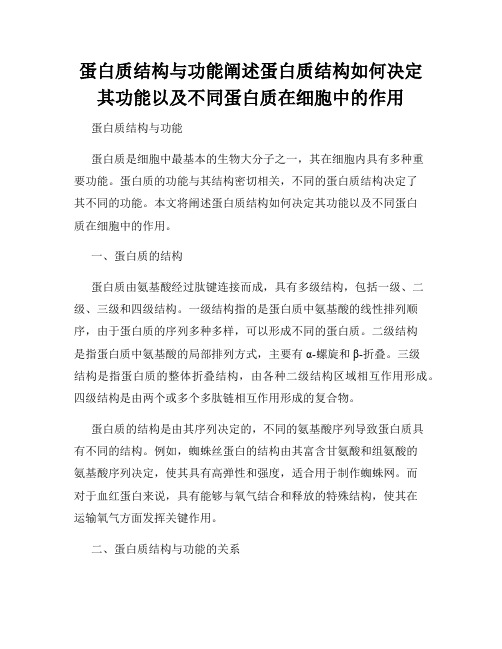
蛋白质结构与功能阐述蛋白质结构如何决定其功能以及不同蛋白质在细胞中的作用蛋白质结构与功能蛋白质是细胞中最基本的生物大分子之一,其在细胞内具有多种重要功能。
蛋白质的功能与其结构密切相关,不同的蛋白质结构决定了其不同的功能。
本文将阐述蛋白质结构如何决定其功能以及不同蛋白质在细胞中的作用。
一、蛋白质的结构蛋白质由氨基酸经过肽键连接而成,具有多级结构,包括一级、二级、三级和四级结构。
一级结构指的是蛋白质中氨基酸的线性排列顺序,由于蛋白质的序列多种多样,可以形成不同的蛋白质。
二级结构是指蛋白质中氨基酸的局部排列方式,主要有α-螺旋和β-折叠。
三级结构是指蛋白质的整体折叠结构,由各种二级结构区域相互作用形成。
四级结构是由两个或多个多肽链相互作用形成的复合物。
蛋白质的结构是由其序列决定的,不同的氨基酸序列导致蛋白质具有不同的结构。
例如,蜘蛛丝蛋白的结构由其富含甘氨酸和组氨酸的氨基酸序列决定,使其具有高弹性和强度,适合用于制作蜘蛛网。
而对于血红蛋白来说,具有能够与氧气结合和释放的特殊结构,使其在运输氧气方面发挥关键作用。
二、蛋白质结构与功能的关系蛋白质的结构决定其功能。
一级结构的区别导致氨基酸序列的不同,进而影响蛋白质的二级、三级和四级结构。
蛋白质的折叠方式会影响其形状、表面特性和空间结构,从而决定了蛋白质的功能。
例如,酶是一种特殊的蛋白质,其结构对于催化化学反应至关重要。
酶的活性位点与其结构密切相关,只有在特定的结构中酶才能与底物结合,并发挥催化作用。
另外,蛋白质的结构与其功能的关系还体现在其特定的结构域上。
蛋白质通常由多个结构域组成,每个结构域都具有特定的功能。
例如,免疫球蛋白是一种抗体,由抗原结合域和效应分子结合域组成,分别负责结合抗原和促使免疫应答。
这种特定结构域的存在使得蛋白质能够在细胞中发挥特定的生物学功能。
三、不同蛋白质在细胞中的作用蛋白质在细胞中扮演着各种不同的角色和功能。
以酶为例,酶是一类催化剂,能够加速化学反应的进行。
3免疫球蛋白

(三)基因工程抗体:
根本出发点:解决抗体的鼠源性问题。 优 点:人源化或完全人源的抗体,均一性强,可工业化 生产。 不足:亲和力低,效价不高。 1、嵌合抗体: • V区来自小鼠,C区来自人; • 降低了鼠源抗体的免疫原性。 2、改型抗体/CDR移植抗体: • 只保留小鼠单抗中的CDR区,其余部分来源于人; • 影响与抗原结合的亲和力。
高变区(hypervariable
region,HVR ):
VH和VL各有3个区域的氨基酸组成和排列顺序高
度可变,分别用HVR1、HVR2、HVR3 表示。
(2)恒定区 (constent
region,C区):
重链和轻链V区以外的氨基酸序列相对稳定,包 括L链近C端的1/2,H链近C端的3/4或4/5。CH和CL
具有抗体活性或化学结构与抗体相似的球蛋 白统称为免疫球蛋白。
两者的关系:Ab都是Ig(结构), Ig不一定都是Ab(抗体活性)。
lg分型: 1、分泌型(secreted Ig, sIg)—主要存在于体液(血 液及组织液),具有抗体的各种功能。 2、膜型(membrane Ig,mIg)—存在于B细胞 表面,构成B细胞膜上的抗原受体。
IgM
是初次体液免疫应答中最早出现的抗体,是机体 抗感染的先头部队。 • 五聚体,分子量最大,又称巨球蛋白,不能通过血管 只存在于血液 • 激活补体和免疫调理作用最强 • 个体发育中合成最早的Ig • 初次体液免疫应答中最早出现的Ab 有助于感染性疾病的早期诊断 • 天然的血型抗体 • 单体IgM是细胞膜表面免疫球蛋白(mIgM) 只表达mIgM是未成熟B细胞的标志 天然存在的血型抗体是IgM
T
Y
利于V区与不同距离的抗原 表位结合暴露补体结合位点
蛋白质化学-蛋白质结构和功能关系

• 变性的本质
—— 破坏非共价键和二硫键,不改变蛋白 质的一级结构。
•造成变性的因素 物理因素:加热、紫外线、X线、超声波 化学因素:乙醇等有机溶剂、强酸、强 碱、重金属离子及生物碱试剂等 。
➢ 变性特征: 生物活性丧失;
理化性质改变:溶解度降低、球状蛋白质的 不对称性增加、粘度增加、扩散系数降低,某 些蛋白质不能够再形成结晶, 变性后分子结构 松散、易被水解,变性蛋白易被酶消化。
2、不可逆沉淀
▪ 定义:蛋白质发生沉淀后,不能用透析等方法除 去沉淀剂而使蛋白质重新溶解的现象
▪ 在强烈沉淀条件下,不仅破坏了蛋白质胶体溶液 的稳定性,而且也破坏了蛋白质的结构和性质, 产生的蛋白质沉淀不可能再重新溶解于水。
▪ 由于沉淀过程发生了蛋白质的结构和性质的变化, 所以又称为变性沉淀。
▪ 如加热沉淀、强酸碱沉淀、重金属盐沉淀和生物 碱沉淀等都属于不可逆沉淀。
肌红蛋白(myoglobin, Mb)
肌红蛋白是一个只有三级结
构的蛋白质,有8段α-螺旋
结构,分别成为A B C D E F G H肽段。整条多肽链折叠 成紧密球状分子,氨基酸残 基上的疏水侧链大都在分子 内部,富极性及电荷的则在 分子表面,因此水溶性较好。 Mb分子内部有个袋形空穴, 血红素居于其中。
(1)抗体的基本结构
Ig分子基本结 构是由四个肽 链组成的。
包括二条较小 的轻链和二条 较大的重链。
轻链与重链之 间是由二硫键 连接形成Ig分 子单体。
(1)抗体的基本结构
(2)可变区和恒定区
➢ 可变区和抗原识别有关,决定抗体识别的特异 性,而恒定区和效应功能相关。
➢ 此外在Y形分子伸出的两臂和主干之间还有个 可弯曲的铰链区(hinge R),能改变两个结合抗 原的Y形臂之间的距离。
免疫球蛋白的基本结构和主要生物学功能
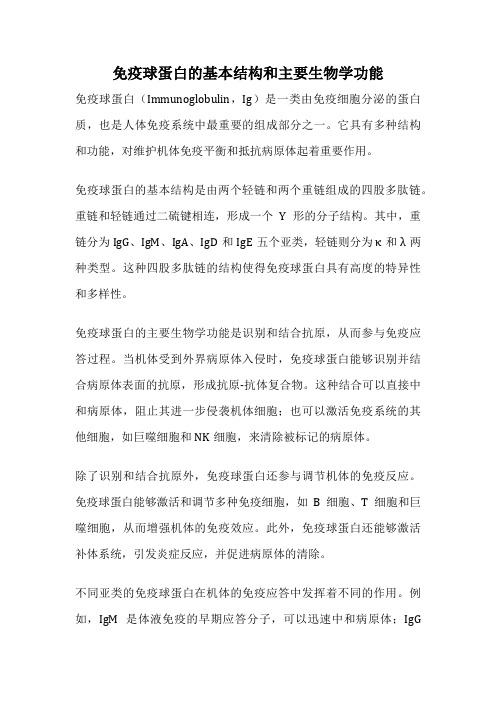
免疫球蛋白的基本结构和主要生物学功能免疫球蛋白(Immunoglobulin,Ig)是一类由免疫细胞分泌的蛋白质,也是人体免疫系统中最重要的组成部分之一。
它具有多种结构和功能,对维护机体免疫平衡和抵抗病原体起着重要作用。
免疫球蛋白的基本结构是由两个轻链和两个重链组成的四股多肽链。
重链和轻链通过二硫键相连,形成一个Y形的分子结构。
其中,重链分为IgG、IgM、IgA、IgD和IgE五个亚类,轻链则分为κ和λ两种类型。
这种四股多肽链的结构使得免疫球蛋白具有高度的特异性和多样性。
免疫球蛋白的主要生物学功能是识别和结合抗原,从而参与免疫应答过程。
当机体受到外界病原体入侵时,免疫球蛋白能够识别并结合病原体表面的抗原,形成抗原-抗体复合物。
这种结合可以直接中和病原体,阻止其进一步侵袭机体细胞;也可以激活免疫系统的其他细胞,如巨噬细胞和NK细胞,来清除被标记的病原体。
除了识别和结合抗原外,免疫球蛋白还参与调节机体的免疫反应。
免疫球蛋白能够激活和调节多种免疫细胞,如B细胞、T细胞和巨噬细胞,从而增强机体的免疫效应。
此外,免疫球蛋白还能够激活补体系统,引发炎症反应,并促进病原体的清除。
不同亚类的免疫球蛋白在机体的免疫应答中发挥着不同的作用。
例如,IgM是体液免疫的早期应答分子,可以迅速中和病原体;IgG则是主要的体液免疫抗体,能够长期保持在血液中,为机体提供持久的免疫保护;IgA主要存在于体液分泌物中,如唾液、泪液、乳汁和肠道分泌物中,起到阻止病原体侵入的作用;IgD主要存在于B 细胞表面,参与B细胞的活化和分化;IgE则参与过敏反应和寄生虫感染的免疫应答。
免疫球蛋白的结构和功能使得它成为人类免疫系统中不可或缺的一部分。
它不仅能够识别和结合多种抗原,还能够激活和调节免疫细胞,从而发挥抗体介导的免疫效应。
免疫球蛋白的研究不仅有助于我们深入了解免疫系统的机制,还为疾病的诊断和治疗提供了重要的依据。
免疫2

(Immunoglobulin,I g)
破伤风外毒素—刺激机体—抗毒素
抗原
中和毒性作用
抗体
抗体antibody,Ab概念:B细胞接受抗原刺激后增殖 分化为浆细胞所产生的具有免疫功能的糖蛋白, 主要存在于血清等体液中。
免疫球蛋白概念:具有抗体活性或化学结构与抗 体相似的球蛋白统称为免疫球蛋白。
两个单体IgA有j 链相互连接形成 二聚体, 五个IgM单体由 二硫键相互连接 并通过二硫键与J 链连接形成五聚 体。 lgG、lgD、lgE 常为单体,无J链
分泌片secretory
piece,SP或分泌成分
component,SC。是分泌型lgA分子上的一个辅助成分, 为一种含糖的肽链,由黏膜上皮细胞分泌
(三)IgA:sIgA——为二聚体,由J链连接,含上皮细 胞合成的SP,经分泌性上皮细胞分泌至外分泌液中, 是分泌液中主要的免疫球蛋白,是粘膜局部免疫的主 要抗体。在黏膜表面也有中和毒素的作用。 (四)IgD铰链区较长,易被蛋白酶水解,故半衰期很短。 mIgD构成BCR,是B细胞分化发育成熟的标志。未成 熟的仅表达mlgM. (五)IgE:含量最少,主要由黏膜下淋巴组织中的浆细 胞分泌。为亲细胞抗体,其CH2和CH3结构域可与肥大 细胞、嗜碱粒细胞上FeRI高亲和力的结合,。引起Ⅰ 型超敏反应。可能与机体寄生虫免疫有关。
两者的关系:所有的抗体都是免疫球蛋白, 免疫球蛋白不一定都是抗体。 lg分型: 1、分泌型(secreted Ig, sIg)—主要存在于体液 (血液及组织液),具有抗体的各种功能。 2、膜型(membrane Ig,mIg)—存在于B细胞 表面,构成B细胞膜上的抗原受体。
一、免疫球蛋白的结构
(一)基本结构— Ig单体 重链(heavy chain,H) 轻链(light chain,L) 链间二硫键 Lg结构像“Y”形 肽链两重与两轻 结合抗原可变区 其余区域是恒定
免疫球蛋白的结构与功能的关系

免疫球蛋白的结构与功能的关系免疫球蛋白(Immunoglobulin,Ig)是一种抗体,它在机体的免疫应答中起着关键作用。
免疫球蛋白的结构与功能密切相关,下面是它们之间的关系:1. 结构:免疫球蛋白由两对轻链和两对重链组成,形成Y字型的结构。
每个链由一系列氨基酸组成,其中有特定的区域负责免疫应答。
2. 抗原识别:免疫球蛋白的功能之一是识别和结合抗原,即外来入侵物质。
抗原结合部位位于免疫球蛋白的变异区域,也称为抗原结合位点(paratope)。
这种高度特异性的结合使得免疫球蛋白能够识别多样化的抗原。
3. 中和抗原:当免疫球蛋白与抗原结合时,它可以中和抗原的毒力或功能,阻止其对机体造成伤害。
这是通过抗体与抗原结合后形成复合物,从而阻止抗原与细胞或组织结合。
4. 激活免疫应答:免疫球蛋白还可以激活机体的免疫应答。
当免疫球蛋白与抗原结合时,其Fc区域(晶体可变片段)可以与免疫细胞上的Fc受体结合,从而触发一系列信号传导路径,引发炎症反应和其他免疫应答。
5. 免疫记忆:免疫球蛋白在机体对抗原作出初次应答后,还能产生长期免疫记忆。
这意味着,如果再次遇到相同的抗原,免疫球蛋白能够更快速、更有效地作出应答,从而保护机体免受感染。
6. 免疫球蛋白就像是身体的超级英雄,它们在抗击疾病的战斗中发挥着重要的作用。
就像正义联盟一样,它们团结一致,共同对抗入侵的敌人。
7. 免疫球蛋白的结构就像是一座坚固的城堡,守护着我们的身体免受病毒和细菌的侵害。
它们就是我们的健康护卫队!8. 免疫球蛋白就像是身体里的特工,他们潜伏在我们的血液中,时刻监视着可能的入侵者。
一旦发现敌人,他们就会立即出击,尽快解决问题。
9. 免疫球蛋白就像是身体的消防队,当病菌肆虐时,他们奋不顾身地扑灭火势,保护我们的身体免受伤害。
10. 免疫球蛋白就像是身体的保安,他们巡逻在我们体内的每个角落,保护我们的健康不受威胁。
11. 免疫球蛋白就像是身体的精英部队,他们训练有素,能够迅速应对各种威胁,确保我们的健康安全。
2免疫球蛋白与抗体

前言上次课我们介绍了免疫学检验的绪论,了解了免疫学的发展,免疫学检验的工作研究方面,更是知道了什么是免疫、免疫功能有哪些,也介绍了免疫学基本理论中的一个重要物质:抗原。
对抗原的两个特性及决定两个特性的因素进行了具体的认识,也知道了医学上有哪些种类的抗原。
那么这次课,我们就来介绍一下与抗原相对应的,在消除抗原中起到重要作用的物质:免疫球蛋白(抗体)第二章免疫球蛋白与抗体抗体(Antibody,Ab):是指能和相应抗原特异性结合的具有免疫功能的球蛋白。
抗体主要存在血液中,也可以存在组织液和外分泌液中,1937年Tiselius用电泳的方法将血清蛋白分成白蛋白、α1 、α2 、β 、及γ 球蛋白等组分,其后证明抗体活性是在γ 球蛋白部分,因此,很长一段时间内,抗体就称为γ 球蛋白(丙种球蛋白)。
实际上,抗体的活性除γ 球蛋白外,还存在α 和β 球蛋白处。
免疫球蛋白(Immunoglobulin,Ig):是指具有抗体活性的或化学结构与抗体相似球蛋白。
包括抗体球蛋白和多发性骨髓瘤患者血清中出现的尚未证明有抗体活性的异常球蛋白。
抗体和免疫球蛋白的关系:抗体是免疫球蛋白,并非所有的免疫球蛋白都具有抗体活性。
第一节免疫球蛋白的结构和功能一、免疫球蛋白基本结构由二硫键连接四条肽链形成的Ig单体分子。
(一)重链和轻链1、重链(heavy chain ):两条相同的长链称为重链,简称H链。
H链约由450—550氨基酸组成,分子量约为50—75KD。
Ig重链恒定区氨基酸的排列顺序不同,抗原性就不同,可将血清中的Ig分成五大类:IgG、IgA、IgM、IgD、IgE,IgG的H 链为γ 链(gamma ),IgA的H链为α 链(alpha ),IgM的H链为μ 链(mu),IgD的H链为δ 链(delta),IgE的H链为ε 链(epsilon)2 、轻链(light chain ):两条相同的短链称为轻链,简称L 链,L 链约由214 个氨基酸组成,分子量约为25KD ,根据L 链抗原性不同,L 链可分为两型,即κ(kappa)型和λ(lambda)型。
免疫球蛋白

免疫球蛋白替代疗法:用于治疗免 疫缺陷病
免疫球蛋白吸附疗法:用于治疗自 身免疫性疾病和过敏性疾病
添加标题
添加标题
添加标题
添加标题
免疫球蛋白输注疗法:用于治疗自 身免疫性疾病
免疫球蛋白靶向疗法:用于治疗肿 瘤和自身免疫性疾病
接种疫苗:通过接种疫苗提高机体免疫力预防疾病
保持良好的生活习惯:保持良好的生活习惯如合理饮食、适量运动、充足睡眠等有助于提高 机体免疫力
免疫球蛋白与感染性疾病:免疫球蛋白可以增强机体的抗感染能力如病毒性肝炎、细菌性肺炎等
免疫球蛋白与肿瘤性疾病:免疫球蛋白可以增强机体的抗肿瘤能力如乳腺癌、肺癌等
免疫电泳法:通过电泳技术分离和检测免疫球蛋白 免疫荧光法:利用荧光标记的抗体检测免疫球蛋白 酶联免疫吸附法:通过酶催化反应检测免疫球蛋白 放射免疫法:利用放射性标记的抗体检测免疫球蛋白 化学发光法:利用化学发光反应检测免疫球蛋白 流式细胞术:通过流式细胞仪检测免疫球蛋白
病的发生
常见自身免疫 性疾病:类风 湿性关节炎、 系统性红斑狼
疮等
免疫球蛋白在感染性疾病中的作用:增强免疫系统抵抗病原体 免疫球蛋白的种类:IgG、Ig、IgM等 免疫球蛋白的合成:由B淋巴细胞产生 免疫球蛋白的检测:通过血清学检测方法进行检测
免疫球蛋白在肿瘤性疾病中的作用:增强免疫系统功能抑制肿瘤细胞生长
结构:由两条重链 和两条轻链组成形成Y字形结构功能:识别并清 除外来抗原保护 机体免受感染
免疫球蛋白有多种 类型如IgG、Ig、 IgM等每种类型都 有其特定的功能
免疫球蛋白存在于 血液、体液和组织 中
免疫球蛋白具有识 别和结合抗原的能 力
免疫球蛋白可以激 活补体系统增强免 疫反应
免疫球蛋白的结构和功能

免疫球蛋白的结构和功能1. 免疫球蛋白的简介哎,免疫球蛋白,听起来就像是一种高大上的科学名词,但其实它就像我们身体里的“超级英雄”。
想象一下,免疫球蛋白(我们常叫它“抗体”)就像是小小的保镖,专门保护我们不被外来入侵者,比如细菌和病毒给打扰。
这些小家伙是由我们免疫系统中的B细胞生产的,简直就是细胞界的“发明家”,随时准备跟入侵者拼个你死我活。
1.1 免疫球蛋白的类型免疫球蛋白可不止一种,它们可是有个大家族呢!主要有五种类型:IgG、IgA、IgM、IgE和IgD。
先说说IgG,这家伙是最常见的,身体里到处都是,可以说是抗体界的“常青树”。
接下来是IgA,它主要出现在我们的粘膜和体液里,比如口水和泪水,像是护卫在我们第一道防线上的守护者。
而IgM呢?就像是新手,刚开始的时候会优先出现。
至于IgE,它与过敏反应有着千丝万缕的联系,见到花粉、尘螨就会跟你闹得不可开交。
最后是IgD,虽然不太常见,但它在B细胞的成熟过程中扮演着重要角色。
1.2 免疫球蛋白的结构说到免疫球蛋白的结构,那可是相当有意思。
它们的形状像个“Y”,两边的手臂就是专门用来抓住那些坏家伙的。
中间的部分则是用来识别入侵者的“锁”,每种抗体都有自己独特的“钥匙”。
这就是为什么免疫系统能精确识别和对付不同的病毒和细菌。
形状的设计简直就是大自然的奇迹,真是让人感叹不已!2. 免疫球蛋白的功能免疫球蛋白的功能简直可以说是多得让人眼花缭乱。
首先,它们最基本的功能就是“中和”那些入侵者。
当病毒或细菌进入身体后,抗体会立马跟它们结合,像是给它们上了锁,这样它们就没法再继续作恶了。
接着,抗体还可以通过吸引其他免疫细胞来帮助消灭这些入侵者,就像是在招呼大伙一起上阵。
2.1 免疫记忆更神奇的是,免疫球蛋白还具备一种“记忆”功能。
就像你见过一个老朋友,过了一段时间再见面,依然认得出来。
当你第一次感染某种病毒后,B细胞会产生特定的抗体,并记住这个“敌人”。
如果同样的病毒再来,你的免疫系统就能迅速反应,派出“老战友”们,简直就是打仗时的特种部队,行动迅速而精准。
免疫球蛋白结构

免疫球蛋白结构免疫球蛋白,又称抗体,是一类由机体免疫系统产生的蛋白质,它在维护机体免疫功能方面起着重要的作用。
免疫球蛋白的结构非常特殊,它由多个亚单位组成,每个亚单位都包含有两个轻链和两个重链。
这种特殊的结构使免疫球蛋白具有高度的特异性和多样性,能够识别和结合到各种不同的抗原上,从而触发免疫反应。
免疫球蛋白的轻链和重链都由多个结构域组成,其中最重要的是可变区(variable region)和恒定区(constant region)。
可变区决定了免疫球蛋白的抗原结合位点,也就是能够与抗原结合的部分。
而恒定区则决定了免疫球蛋白的功能,如激活免疫细胞、结合补体等。
免疫球蛋白的可变区非常特殊,它由大量的多样性基因片段通过基因重组的方式产生。
这种多样性基因片段的存在使得每个免疫球蛋白的可变区具有非常高的多样性,能够识别和结合到各种不同的抗原上。
这也是免疫球蛋白能够有效应对各种病原体的原因之一。
除了可变区和恒定区外,免疫球蛋白还具有其他一些重要的结构域,如补体结合区和糖基化区。
补体结合区位于免疫球蛋白的恒定区,能够结合和激活补体系统,从而增强免疫反应的效果。
糖基化区则位于免疫球蛋白的重链上,通过糖基化修饰可以增加免疫球蛋白的稳定性和溶解度。
免疫球蛋白的结构不仅决定了它的功能,也决定了它的特性。
例如,由于免疫球蛋白的结构特殊,它在体内可以形成多种不同的构象,如单体、二聚体、四聚体等。
这种构象的存在使得免疫球蛋白具有不同的功能和效果。
另外,免疫球蛋白的结构还决定了它的稳定性和半衰期,这对于维持免疫功能的持久性非常重要。
总结一下,免疫球蛋白的结构非常特殊,它由多个亚单位组成,每个亚单位都包含有轻链和重链。
免疫球蛋白的结构域包括可变区、恒定区、补体结合区和糖基化区等。
这些结构域的存在使得免疫球蛋白具有高度的特异性、多样性和功能性。
免疫球蛋白的结构不仅决定了它的功能和特性,也对免疫功能的持久性起着重要的作用。
通过对免疫球蛋白结构的研究,科学家们可以更好地理解免疫系统的工作原理,从而开发出更加有效的免疫治疗方法。
- 1、下载文档前请自行甄别文档内容的完整性,平台不提供额外的编辑、内容补充、找答案等附加服务。
- 2、"仅部分预览"的文档,不可在线预览部分如存在完整性等问题,可反馈申请退款(可完整预览的文档不适用该条件!)。
- 3、如文档侵犯您的权益,请联系客服反馈,我们会尽快为您处理(人工客服工作时间:9:00-18:30)。
Antibodies are Proteins that Recognize Specific Antigens 抗体能够特异性的识别抗原
Immunoglobulin Structure-Function Relationship
• Cell surface antigen receptor on B cells
B 细胞表面受体和分泌的抗体 Allows B cells to sense their antigenic environment Connects extracellular space with intracellular signalling machinery
特点是其双硫键,连接了110个氨基酸).
Ig gene superfamily - IgSF
The genes encoding Ig domains are not restricted to Ig genes.
Although first discovered in immunoglobulins, they are found in a superfamily of related genes, particularly those encoding proteins crucial to cell-cell interactions and molecular recognition systems.
免疫球蛋白的结构与功能的关系
Epitopes(抗原决定簇 ): Antigen Regions that Interact with Antibodies
结构域源于一个原始基因,复制,多元化,修饰等) • Ig domains are not restricted to immunoglobulins (Ig 结构域不仅 仅局限于免疫球蛋白).
• The most striking characteristic of the Ig domain is a disulphide bond - linked structure of 110 amino acids long(Ig结构域最明显的
• Structural conservation and infinite variability - domain structure(结构 上不仅保守而且无限可变的). • The Immunoglobulin Gene Superfamily (免疫球蛋白的超家族) • The immunoglobulin fold (免疫球蛋白的折叠) • Framework and complementarity determining regions - hypervariable
loops (框架结构和可变区) • Modes of interactions with antigens (与抗原相互作用的模型) • Effector mechanisms and isotype – role of the Fc. (Fc 区的作用) • Multimeric antibodies and multimerisation • Characteristics and properties of each Ig isotype • Ig receptors and their functions
• whilst simultaneously recognising an infinite array of antigenic determinants. (同时能够识别无限抗原族)
Immunoglobulin domains
• Structural conservation and a capacity for infinite variability in a single molecule is provided by a DOMAIN structure. (结构上不仅保守而且无限可变的- 抗体结构域)
• Secreted antibody (抗体)
Neutralisation (中和作用) Arming/recruiting effector cells (激活或者诱导功能细) Complement fixation (帮助机体对抗原的清除)
Immunoglobulins are Bifunctional Proteins
• Ig domains are derived from a single ancestral gene that has duplicated, diversified and been modified to endow an assortment of functional qualities on a common basic structure(Ig
• Immunoglobulins must interact with a small number of specialised molecules - (免疫球蛋白必须与特殊分子相互作用)
Fc receptors on cells (细胞表面的Fc受体) Complement proteins (辅助蛋白) Intracellular cell signalling molecules (细胞内信号转导分子)
Immunoglobulin StructureFunction Relationship
免疫球蛋白的结构与功能的关系
Immunoglobulin Structure-Function Relationship
• Signalling antigen receptors on B cells - bifunctional antigen-binding secreted molecules(B 细胞表面受体和分泌的抗体)
